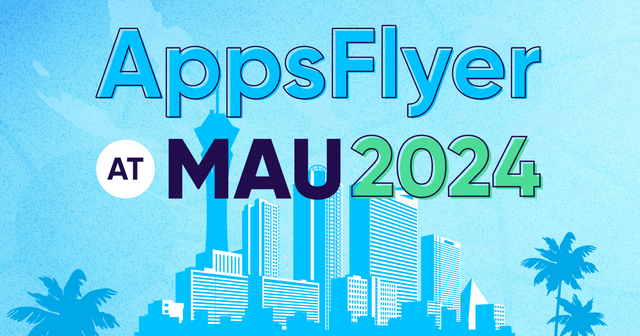
Follow the money: the power of in-game mobile advertising
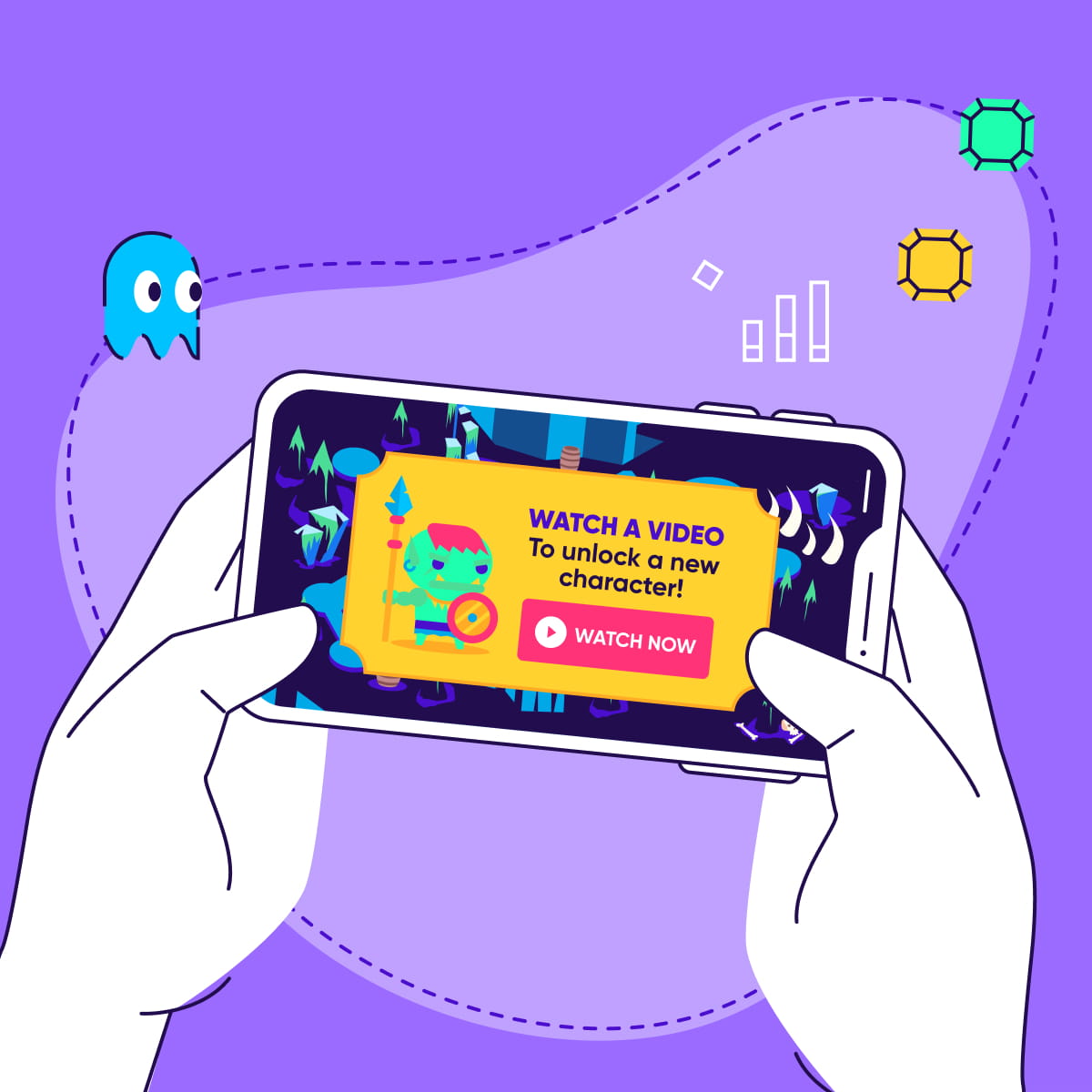
On the train, in the waiting room, even walking down the street… Everywhere you look, people are fixed on their phones. Some might be checking work emails or keeping up with the news — but statistically, there’s a strong chance they’re playing a game.
Statista reports that worldwide, more than 1.75 billion of us played mobile games in 2022. Others put that figure well over 2 billion. We also know mobile accounts for more than half of online gaming revenues, and games are the most downloaded app category across both Apple’s App Store and Google Play. Mobile games are having a moment: the industry generated around $92 billion in 2022.
So how did we all fall in love with pocket gaming? Well, Covid-19 has a lot to answer for. The 2020 lockdown was a major boost for the industry, as millions of us found ourselves stuck at home with time on our hands: installations shot up 45% on the previous year. We’ve passed that peak, but other factors like fast-growing smartphone adoption and growing intranet infrastructure worldwide keep the market healthy.
It’s no surprise that advertisers want a slice of the pie: ironSource estimates that overall, mobile game advertising revenue is approaching $39.8 billion. The obvious benefit is the vast and increasingly diverse audience: from Candy Crush to Roblox to Clash of Clans, there’s a game for everyone, providing opportunities to connect with your ideal customers.
In this blog, we’ll cover everything you need to know about in-game advertising, including the benefits, challenges, top tips, and trends.
What is in-game advertising?
In-game advertising is a way of monetizing games by incorporating ads within them. Ads can be shown in electronic games on all platforms and devices. Here, we focus on mobile: in other words, gaming apps for mobile phones and tablets.
In the mobile gaming world, in-app advertising (IAA) is the key monetization strategy (the main alternative being in-app purchases, or IAP). With many apps free to download, game publishers sell space to advertisers as a way to make money and stay profitable. This is particularly true of hyper-casual games, which are quick and easy to start playing but often have high churn rates.
In-game ads may be static or dynamic. Static ads are built into the code of the game — for example, a billboard at an online sports field. As such, they usually can’t be changed. Dynamic ads, on the other hand, can be updated in real time, giving advertisers more flexibility and allowing for improved targeting. This makes dynamic ads the more popular choice.
Mobile in-game ads come in multiple formats. For example, you’ll often see a banner ad at the top or bottom of your screen. Other options are interstitials (which fill the whole screen at natural breaks in the game) or rewarded video ads (where users can earn points or win extra lives for watching to the end).
Most users are happy to accept some ads when they’re playing a free mobile game, as long as they don’t interrupt play unnecessarily.
What are the benefits of in-game advertising?
In-game advertising creates a symbiotic relationship between publishers and advertisers. For advertisers, in-game ads are an engaging way to interact with users in their ideal audience. For publishers, ads are an effective revenue driver and provide a gateway for users to spend more within the app. Let’s dig a little deeper.
Generate revenue – and lots of it

In a world where free-to-play dominates the marketplace, integrating advertising into your mobile game can generate scalable revenue. According to Venturebeat, in-game ad revenue is projected to reach $56b in 2024.
Increase in-app purchases with psychology
Rewarding players with in-game currency for interacting with ads can show users the value of in-app purchases without committing to anything besides watching an ad. Ultimately, it uses the foot-in-the-door technique, orgetting a prospect to agree to do something small to increase the likelihood of getting them to accept a bigger task. In this case, spending money for in-game benefits.
Get your gamers to game some more
The most effective in-game ad strategy pairs good user experience with an effective reward system. Offering your players high-value rewards can keep them engaged for longer, incentivizing them to come back and continue playing your game. Feeding the reward loop is both an art and a science that requires testing.
Reward loop definition: A system that rewards users for certain behaviors to encourage habitual behavior to keep users engaged for longer periods of time.
Reach new audiences far and wide
No longer the preserve of teenage boys, today’s mobile games appeal to a truly diverse audience: Udonis reports that 55% of players are now female, and the average age is 36. In fact, two-thirds of all internet users aged 55 to 64 play video games. Many of these newer players wouldn’t describe themselves as ‘gamers’ — yet games are a great place to find them.
The global reach is growing too, as mobile and internet provision expand rapidly in developing markets.
Stay in control
An advantage of online gaming is that you know exactly where your ad will appear. There’s no user-generated content, so no risk that your brand appears in an inappropriate place and gets tarnished by association.

Challenges of in-game advertising
We’ve seen that in-game advertising has a lot going for it, but the model isn’t without its challenges. Here are the key ones to look out for.
User experience risk
Poor advertising practice ruins things for everyone. Mobile gamers are accepting of ads, up to a point: if ads are too intrusive, too frequent, or just not relevant, players are likely to walk away. That has a knock-on effect for publishers and advertisers, whereby the very thing that was supposed to make you money ends up draining it.
Google’s recent ban on intrusive interstitial ads (which take up the whole screen and interrupt play when the user didn’t expect it) on Android is designed to weed out the worst of the bad ads.
Ad fatigue
In-game ads have become so common that many players see them as wallpaper — just something they have to put up with to enjoy a free game. Banner ads, in particular, suffer from low click-through rates, so use them with care and carry out robust audience research and A/B testing to make sure they resonate.
Indeed, some users are so tired of ads they install ad-blocking software, meaning your carefully crafted and budgeted campaign will never reach them.
High costs, high competition
The scale of the in-game advertising opportunity means everyone wants to join the party: Admix states that 93% of media buyers aim to run in-game advertising by 2023. That means tough competition for the most popular spots, and publishers can afford to charge more for valuable inventory. On the advertiser side, you need to be sure it’s worth the investment.
The privacy problem
Gathering user-level data has gotten a whole lot harder of late, with Apple’s all-important ATT (App Tracking Transparency), introduced on the back of iOS 14, and a new Privacy Sandbox on the way from Android. As marketers work to get to grips with Apple’s SKAN, many are in the dark when it comes to data visibility and campaign measurement. That explains why Android app installs are up 8% year-on-year, while Apple installs have fallen 5%.
The key is to explore solutions like predictive analytics, which can help you optimize campaigns without falling foul of the rules.
8 types of in-game advertising formats
Rewarded ads & rewarded video ads (RV)
Rewarded video ads offer users in-game bonuses in exchange for watching a full-screen ad. These ads range from 15 seconds to one minute and usually can’t be skipped.
Rewarded ads provide a positive experience for both users and publishers, as users don’t have to pay for superior content such as winning in-game currency, unlocking new levels, or receiving unique items. Average revenue per completion tends to be slightly lower than for interstitials, but they’re great for exposure and building engagement.
Interstitial ads
Interstitial ads are full-screen and interactive advertisements that appear between in-game activities or levels. These ads provide high visibility, but due to their potentially disruptive nature, it’s important for advertisers to use interstitials sparingly and non-invasively.
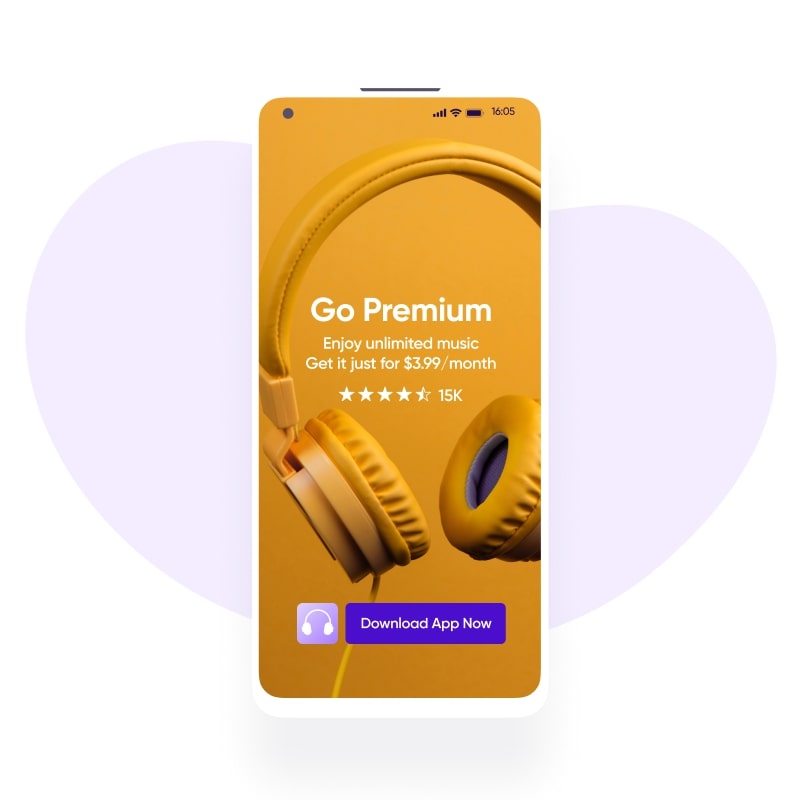
Users are then prompted to do one of the following:
- Watch through the entire ad
- Engage with the ad and visit the promotional page
- Skip the ad after a five-second delay
Interstitials also typically end with a call to action to download the app. Interstitials are most effective in between stages, where they don’t interrupt the flow of the game.
Interstitial definition: To be in between two things. In advertising, interstitial ads play in between levels or achievements.
Display banners
The most common type of ad is the display banner. They’re often at the top or the bottom of your screen with rotating designs and creatives. However, due to banner blindness, performance on native banners is trending down. They have low viewability, recall, and oftentimes generate little to no revenue. On the other hand, ad placements are cheaper for advertisers who want to run a large-scale branding campaign.

Banner Blindness definition: Advertisements and ads appearing in locations traditionally reserved for advertising are increasingly being ignored by users.
Playable ads
Playable ads are interactive ads where users are prompted to play a quick demo of the game they’re advertising. According to SmartyAds, this gamified ad format performs 8x better than traditional interstitial ads. The ads come in three parts:
- A quick explanation of game mechanics
- A short, playable demo
- A call to action to download the game
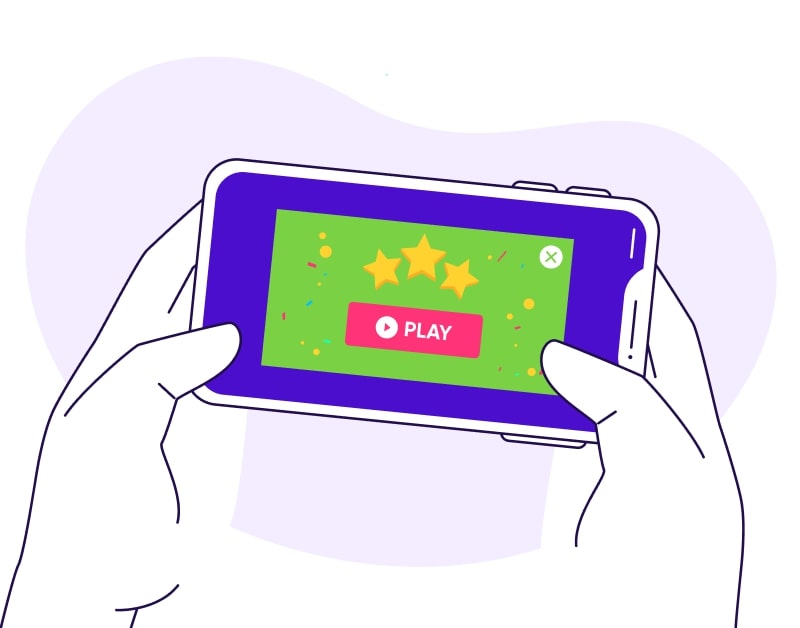
Gamify definition: to include elements of a game to reward interactivity with something that traditionally does not engage with the user.
Offerwall
Similar to rewarded ads, offerwalls ask users to install other apps, fill out surveys, or play games in exchange for in-game rewards.
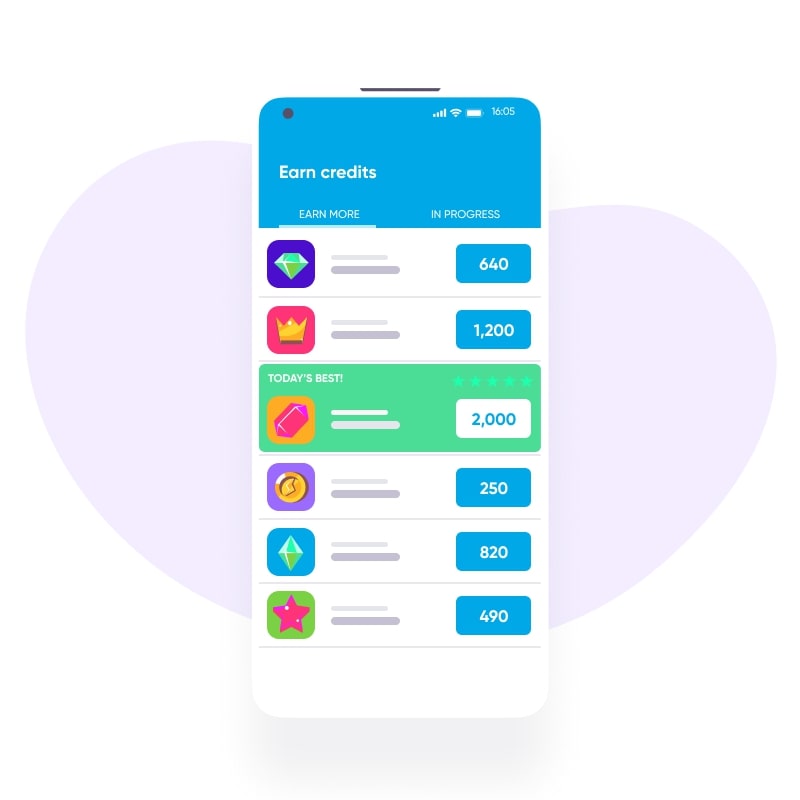
While these ads typically bring the highest average revenue per completion, many ad networks have banned offerwalls due to low performance. In 2018, Apple began cracking down offerwalls as they deemed it to be a way to manipulate the App Store charts.
Coupon ads
Coupon ads provide users unique voucher codes to redeem prizes and discounts in the real world. This online-to-offline strategy targets advertisers focused on driving foot traffic with physical brick-and-mortar locations.
Online to Offline (O2O) definition: a marketing strategy to draw sales in physical stores using online channels
Cross-promotional ads
Cross-promotional advertising is the marketing strategy of promoting a parent company’s apps on your own network. It’s particularly popular in the high-churn world of hyper-casual gaming, where a user might tire of one game but be open to playing another, similar one.
This strategy is a free way to promote your highest revenue-generating game at no cost, as well as saving you money on selling ad space to other advertisers. However, we recommend you exclude your highest spenders in cross-promotional ads to keep them spending on the games they already love.
The most popular mobile game genres
Mobile games really do offer something for everyone. In this section, we run through popular types of games and which ad formats work best for each one.

Action
Ranging from platformers to beat ‘em ups, action games focus on dexterity, reaction-time, and hand-eye coordination to overcome difficult challenges.
Rewarded video ads work exceptionally well in these games for players who want to boost their stats or obtain new items. Additionally, action gamers are more likely to become paying players once they realize the exponential benefit of paid or gifted items, so be sure to reward players who engage with your ads and increase your opportunities for in-game purchases.
Examples: Brawlhalla, Mortal Kombat, Walking Dead
Arcade
Classic-style games require skill for one unique game mechanic, this genre saw the biggest revenue growth in 2022. Rewarded video ads and interstitial ads work well if the arcade game has multiple levels (serve the ads between levels to avoid interrupting play). Consider offering extra lives or reward multipliers for engaging with an ad.
Examples: PacMan, Doodle Jump, Subway Surfers, Monster Dash
Battle Royale
These are online, multiplayer games that use the elements of survival, last-man standing, and scavenging.
Similar to action games, consider a luck wheel or rewarded video ads when a player needs an extra boost. You may draw inspiration from Call of Duty’s $1.1 billion mobile monetization strategy. Consider offering free bundles, crates, or even credits for engaging with a video ad.
Examples: PUBG, Fortnite, Call of Duty Mobile, Brawl Stars
Casual
These low-stakes games are aimed at a mass market for hobbyists. You’ll also see the terms hyper-casual and hybrid-casual (a new format offering more progression and engagement). As with arcade games, consider non-intrusive interstitial ads in between levels to create a seamless gaming experience.
Examples: Bloons TD, Stack, Crossy Road
MMORPG
Massively multiplayer online role playing games (MMORPG) involve online play, controlling and growing your own character, and role-playing. Due to the immersive nature of MMORPGs, in-app advertising is more difficult than with other genres. Hardcore gamers play for hours a day and constant engagement is a priority for publishers.
Examples: Genshin Impact, Raid: Shadow Legends, Adventure Quest, Albion Online
MOBA
Multiplayer online battle arena (MOBA) games involve two teams of players competing to score goals or take over opposing team structures. The most common ads here include interstitials and rewarded video ads.
Examples: Vainglory, Mobile Legends, Arena of Valor
Puzzle
Puzzle games require logical and conceptual skill to beat. Similar to casual games, interstitial ads in between levels are the most common form of advertising.
Examples: Two Dots, Move the Block, Sudoku, 2048
Sports
As the name suggests, these games emulate sports including basketball, soccer, baseball, and more. Rewarded video ads are very common for sports games.
Examples: FIFA, Golf Star, MLB 9, NBA 2K series
Trivia
These quiz-style games test extensive and broad knowledge across multiple subjects. Trivia games often involve lightning-fast rounds, which makes quick and snappy interstitial ads an effective form of advertising.
Examples: Who Wants to Be a Millionaire, Trivia Crack, Brain Test
Word
As a subgenre of puzzle games, word games involve wordplay, spelling, or rearranging of letters. They can also have levels, which are useful for interstitial ad placements. However, for longer crossword or sudoku games, banner ads are also very common.
Examples: Wordscapes, Crossword, Four Letters, Wheel of Fortune
How to identify your target audience

As we discussed previously, mass gaming adoption has allowed advertisers to reach a wide range of audiences across the world. There’s no longer a ‘typical’ gamer profile. So, to ensure your advertising resonates with your ideal audience, you must understand the psychology and behaviors of your key personas. A good place to start is to conduct a survey or leverage research companies to help you form your personas, digging into their wants, needs, and the challenges they face.
Alternatively, GameRefinery developed eight key player archetypes that can help inform your decision. Once you’ve built out your ideal customer profile, map them to the types of games your audience would most likely connect with.
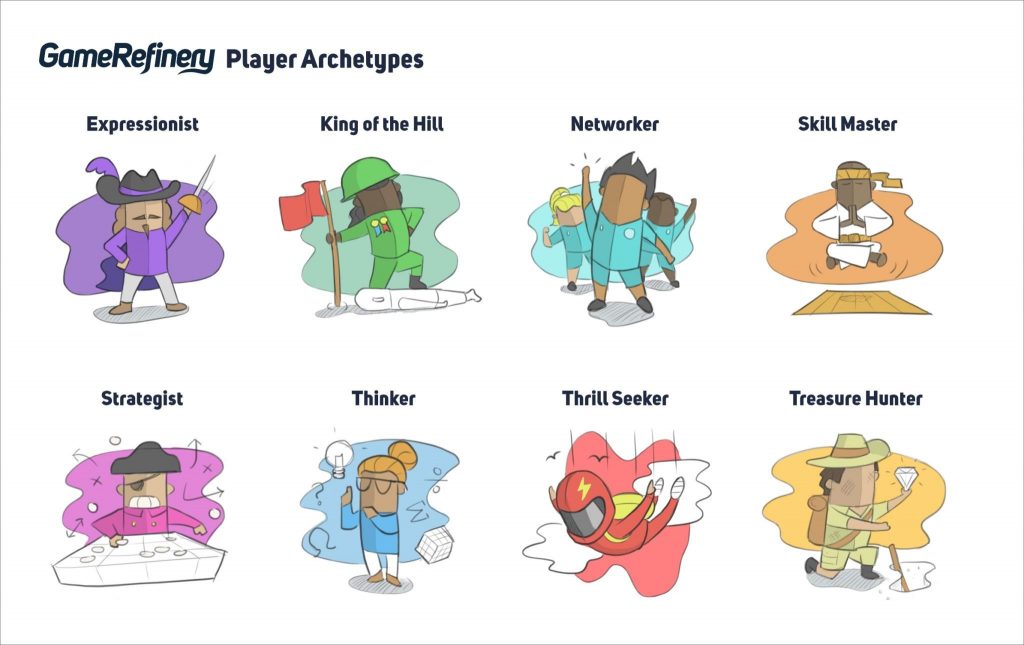
Five ways to improve your in-game advertising
Now we’ve covered the ‘what’ and the ‘why’ of mobile gaming ads, it’s time to dive into the ‘how’. Here are some key strategies you can use to develop ads that get results.
1. Obsessively iterate to generate great creatives
There’s no better way to get people excited about your game than producing great ad creatives. Show the most fun aspects of your game while staying true to your game experience. Preview the pivotal aspects of your game first as a hook, be quick to reveal the punchline, and have a clear call to action (and don’t forget to A/B test everything).
2. Leverage remarketing for gaming apps
Noticed your players drifting away? Consider a remarketing campaign to reignite the spark and boost average revenue per paying user. Remarketing campaigns can remind users what they love about your game, and are most effective when paired with push notifications, email marketing, and social media marketing to re-engage with your paying users off-platform.
Remarketing on Apple has dropped due to the data constraints of ATT, but remains popular on Android — our research shows a 22% increase in this tactic in 2022.
3. Optimize the bigger picture
In-game advertising is just one part of your overall marketing mix: you need every cog in the machine working, and all of them working together. Go right back to your app store listing and check that it’s optimized so the right users will find you. And revisit your website and landing pages — when users click on your ad, will they like (and understand) what they see?
From your banners to your socials, a consistent look, feel, and message will strengthen your brand and bring the benefits of your proposition to life.
4. Hedge against fraud
According to our research, gaming apps see low install fraud rates but are at higher risk for in-app fraud. Fraudsters are targeting post-install in-app events to tinker with CPA events beyond the download. Invest in fraud protection technology to avoid wasted dollars and show your players that you’ve got their back.
5. Measure your success
Dumping money on advertising without measuring performance is the equivalent of ‘spraying and praying’ in a shooting game. Mobile advertising is an investment that can pay off handsomely when you pay close attention to attribution. The worst thing you can do is leave it to ‘best guess.’
Set up proper ad revenue attribution to pinpoint your best sources of traffic. With more data, you can start delivering to the right users who are most likely to engage with your ads – in the right place and at the right time. Who wouldn’t want that?
Of course, the starting point is to be clear on what you’re measuring. Is your goal to boost volume? Or are you trying to maximize ROAS? Are you measuring success based on cost-per-action or cost-per-click? Our whiteboard session about maximizing rewarded traffic will get you set up for success.
The future of in-game advertising: trends to watch
In-game advertising is here to stay on mobile — but what might the future bring?
Doing more with less
We’ve all gotten used to hearing those words as the cost-of-living crisis has started to bite. Customers are feeling the pinch and less willing to spend. With marketing budgets tightening, smart targeting is key to achieving the best returns. Owned media is on the rise too, with social media, push notifications and cross-promotion all helping keep users engaged: because loyal customers equal higher lifetime value and better ROAS.
Improved creatives
Gone are the days of just bursting onto your users’ screens with a bunch of flashy graphics, hoping someone clicks. Neither gamers nor publishers will stand for it – and smart advertisers want to do better. Boring banners won’t cut it either, so it’s time to get (even more) creative and invest in high-quality, thoroughly-tested copy and design that reflects your brand and speaks your audience’s language.
Leveraging CTV
The rise of CTV, or connected TV, is a huge boon for app marketing. It enables you to identify audience segments with pinpoint accuracy, and promote the games you know they’ll love. Best of all, because it allows users to watch TV on their mobile device, they can tap straight into your game while it’s top of mind.
An ad-free future?
In-game advertising is the most popular way to monetize mobile games, but it’s not the only way. In fact, the most dedicated players may be willing to pay for an experience without ads. Does this spell the end for in-app advertising? No, because free, ad-supported games are still the most popular choice – but more publishers are exploring hybrid monetization approaches that combine IAA and IAP.
Key takeaways
- Mobile gaming continues to grow in popularity, with an increasingly diverse audience. This provides a huge opportunity for advertisers to reach their ideal customers through in-game ads, and publishers can benefit by selling ad space.
- Other benefits of in-game advertising include the ability to generate revenue, keep gamers engaged, and stay in control of your brand.
- Privacy restrictions, particularly on iOS, have made accurate targeting and measurement more challenging. Other difficulties include fatigue or frustration with ads, and rising costs.
- There are multiple types of mobile games (arcade being the most popular), and you should choose the best ad format for each one – for example, banner ads, interstitials, or rewarded video.
- Research the game audience carefully to ensure their personas align with your own, and develop creatives to attract and engage them.
- To improve your results, keep testing, iterating, and measuring success against clear goals.





